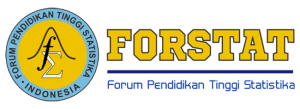Pemodelan Mixed Geographically Weighted Regression-Spatial Autoregressive (MGWR-SAR) pada Kasus HIV di Indonesia
DOI:
https://doi.org/10.34123/jurnalasks.v15i2.608Keywords:
Geographically Weighted Regression, Human Immunodeficiency Virus, mixed geographically weighted regression, spatial autoregressive regressionAbstract
In general, spatial regression is used to model one of the spatial effects, namely spatial dependency or heterogeneity. For the effects of spatial dependencies, the models that have been used frequently follow Elhost's taxonomy, with the spatial dependencies being on the response, predictor, or error. Whereas for the effect of spatial heterogeneity generally use geographically weighted regression models (GWR) or if there are global predictors use mixed geographically weighted regression (MGWR). The data used in this study are cases of Human Immunodeficiency Virus (HIV) per 100,000 population as a response variable, and key populations, positive cases in pregnant women, tuberculosis patients, poverty rate, and unemployment rate as predictors. In the data used, there are spatial dependencies and heterogeneity. The MGWR-SAR is a model that can be used if the data has both spatial effects. This study aims to determine the factors influencing HIV cases in districts/cities in Indonesia using a spatial model. The results showed that the combined model of GWR and spatial autoregressive regression (SAR) was the best model. Key population explanatory variables have a global and significant influence. Other explanatory variables that have local influence are positive cases in pregnant women, tuberculosis patients, poverty rates, and unemployment rates.
Downloads
References
Anselin, L. (1988) ‘Spatial Econometrics: Methods and Models’, Econometrica [Preprint]. Kluwer Academic Publishers. Available at: https://doi.org/10.1111/j.1468-0262.2004.00558.x.
Apriyani, N.F., Yuniarti, D. dan Hayati, M.N. (2018) ‘Pemodelan Mixed Geographically Weighted Regression (MGWR) (Studi Kasus: Jumlah Penderita Diare di Provinsi Kalimantan Timur Tahun 2015)’, Jurnal Eksponensial, 9(2012), pp. 59–66.
Arbia, G. (2006) Spatial Econometrics Statistical Foundations and Applications to Regional Convergence. Berlin: Springer-Verlag.
Astuti, H.N., Saputro, D.R.S. and Susanti, Y. (2017) ‘Mixed Geographically Weighted Regression (MGWR) Model with Weighted Adaptive Bi-Square for Case of Dengue Hemorrhagic Fever (DHF) in Surakarta’, Journal of Physics: Conference Series, 855(1). Available at: https://doi.org/10.1088/1742-6596/855/1/012007.
Comber, L. dan Brunsdon, C. (2021) Geographically Data Science & Spatial Data Analysis: An Introduction in R. SAGE.
Djuraidah, A. (2020). Monograph Penerapan dan Pengembangan Regresi Spasial dengan Studi Kasus pada Kesehatan, Sosial, dan Ekonomi. Bogor: IPB Press.
El-Kautsar, M.B., Djuraidah, A. dan Angraini, Y. (2022) Identifikasi faktor-faktor yang memengaruhi kasus HIV di Indonesia tahun 2018 menggunakan regresi terboboti geografis campuran. Institut Pertanian Bogor.
Fotheringham, A.S., Brunsdon, C. dan Charlton, M. (2002) Geographically Weighted Regression: the analysis of spatially varying relationships. John Wiley & Sons. Inc.
Furková, A. (2021) ‘Implementation of MGWR-SAR Models for Investigating a Local Particularity of European Regional Innovation Processes’, Central European Journal of Operations Research [Preprint]. Available at: https://doi.org/10.1007/s10100-021-00764-3.
Geniaux, G. dan Martinetti, D. (2018) ‘A new method for dealing simultaneously with spatial autocorrelation and spatial heterogeneity in regression models’, Regional Science and Urban Economics, 72, pp. 74–85. Available at: https://doi.org/10.1016/j.regsciurbeco.2017.04.001.
Gujarati, ND. dan Porter, DC. (2009) Basic Econometrics. Fifth Edition. New York: The McGraw-Hill/Irwin.
Kemenkes RI (2019) Profil Kesehatan Indonesia 2018, Health Statistics. Jakarta.
Kusnandar, D., Debataraja, N.N. dan Fitriani, S. (2021) ‘Pemodelan Sebaran Total Dissolved Solid Menggunakan Metode Mixed Geographically Weighted Regression’, Jurnal Aplikasi Statistika & Komputasi Statistik, 13(1), pp. 9–16. Available at: https://doi.org/10.34123/jurnalasks.v13i1.257.
Lu, B. et al. (2014) ‘The GWmodel R package: Further topics for exploring spatial heterogeneity using geographically weighted models’, Geo-Spatial Information Science, 17(2), pp. 85–101. Available at: https://doi.org/10.1080/10095020.2014.917453.
Olakunde, B.O. et al. (2021) ‘Spatial analysis of HIV infection and the associated correlates among transgender persons in the United States’, Psychological and Socio-medical Aspects of AIDS/HIV, 34(8). Available at: https://doi.org/https://doi.org/10.1080/09540121.2021.1929817.
Shekhar, S. et al. (2018) ‘Spatial and Spatiotemporal Data Mining’, in B. Huang (ed.) Comprehensive Geographic Information Systems. Elsevier, pp. 264–286. Available at: https://doi.org/https://doi.org/10.1016/B978-0-12-409548-9.09594-4.
















